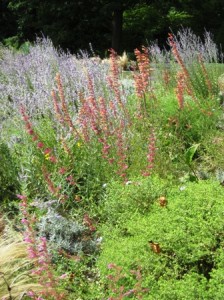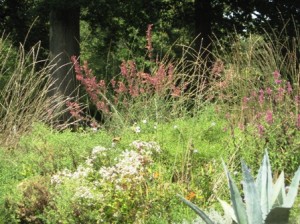 Agastache, one of those plants that most of us gardeners drool over when we see it in catalogues, received mix reviews this month.
Agastache, one of those plants that most of us gardeners drool over when we see it in catalogues, received mix reviews this month.
Frances wrote that she ordered ‘Black Adder’ from High Country Gardens last year and that it survived this spring but didn’t grow a whole heck of alot this year. Frances, any chance that it had a growth spurt as the summer progressed?
On the other hand, Rhonda gave ‘Blue Fortune’ the highest of compliments, nominating it for her Defiant And Thriving Award: it just keeps on growing regardless of soil conditions.
Cameron reminded us that agastache attracts wonderful wildlife….both birds and butterflies.
Kim, who is in Zone 7, and who was in the midst of redesigning her garden last month, told us that she bought both ‘Black Adder’and ‘Blue Fortune’ for this garden. We’ll be curious to hear what she says about how they fared as the season progressed.
David Salman, the owner of High Country Gardens, suggested that for those of us who have had problems with ‘Black Adder’ to not only plant with ‘Blue Fortune’ instead but to try other natives such as Cana, Ava and rupestris. He said that all should be planted in sandy soil (which I’ve never done (perhaps that’s why so many have disappeared) and to use a slow release fertilizer.
And in Nan’s post of yesterday, she also mentioned trying ‘Blue Fortune’ with much success the first couple of years but that it did not show up in its 3rd year. Like several of us gardeners on the East Coast, she has had success with rupestris, although she treats this agastache as an annual. Nan and I both have had good luck with ‘Golden Jubilee’: she mentioned some ways of keeping it from looking scraggly and worn out by mid-summer.
 Since David Salman is one of the foremost experts on agastaches in this country, we can all learn some tips from him on the best way of getting them to bloom for us consistently and for longer than for a few years, especially for those of us in USDA Zones 5-7.
Since David Salman is one of the foremost experts on agastaches in this country, we can all learn some tips from him on the best way of getting them to bloom for us consistently and for longer than for a few years, especially for those of us in USDA Zones 5-7.
